Tags
Byron Nordberg, California High Speed Rail, Coaster Rail Service, Los Angeles Union Station, Metrolink, Oceanside Resort Hotels, Oceanside Transit Center, Wilshire Subway
By Noel T. Braymer
One of my mentors who taught me about rail passenger service was Byron Nordberg. We both joined what was called in 1979, Citizens for Rail California (CRC) at about the same time. CRC now does business as RailPAC. It was Byron’s idea to change the organization’s name in roughly the mid 1980’s. Long before 1979, Byron was planning improvements for rail passenger service in Southern California. He started around 1970, just before the creation of Amtrak when Byron went to the Oceanside Chamber of Commerce of which he was a member. He proposed the construction of an intermodal transportation center at the Santa Fe Train Station near the beach in downtown Oceanside. This became the first intermodal station built in California if not in the US. A major goal of Byron’s plan was to both make it easier for people to travel without a car to and from Oceanside. Another goal was to turn around the blighted areas around the train station which included a rail freight yard. Byron’s long term plan was to turn the beach area of downtown Oceanside from a “rough part of town” into a successful beach resort. It was early 1984 before Byron’s Oceanside Transit Center first opened to the public with plenty of vacant lots nearby. What I remember most was Byron had a coffee cup with the Latin phrase “Illegitimi non carborundum”. It roughly translates as ” Don’t Let The Bastards Grind You Down”.

Photo from late 1983 during construction of the Oceanside Transit Center. To the right facing west is the Oceanside, Santa Fe Freight Yard. To the left facing east is the original platform under construction for the Transit Center. Photo was shot from the Santa Fe station platform. Photo by Noel T. Braymer
Nothing happens overnight, not even overnight successes. When the Oceanside Transit Center first opened in 1984 there were 7 round trip San Diegan trains between Los Angeles and San Diego. There was also Greyhound and Continental Trailways intercity bus service and a handful of local transit buses which terminated at the Transit Center. This also made it easier for bus and rail passengers to transfer between services. Since 1984 we now have 11 round trips Between San Diego and Los Angeles with 5 extended to Santa Barbara and 2 to San Luis Obispo . The San Diegans were rebranded as the Pacific Surfliners in 2000. With ridership growth a 2nd track and platform was built which were connected by a tunnel under the tracks for safety reasons. The tunnel can also be used for people to walk to the beach in safety from the station. In the 1990’s Metrolink service was extended to Oceanside from Los Angeles and San Bernardino. By 1995 Coaster commuter rail service started up between Oceanside and San Diego. By 2008 there was even DMU (diesel multiple unit) rail service between Oceanside and Escondido running every 30 minutes in both directions.
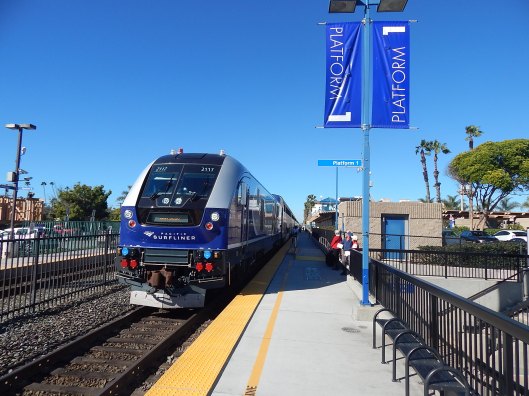
This is a recent view looking north from the recently rebuilt platform at Oceanside. To the right are the ramps and stairs to the pedestrian tunnel to Platform 2 to the west. There is also a third platform to the south and east used for Coaster Trains. Photo by Noel T. Braymer
These improvements didn’t just happen. Byron in large part made them happen. He had a contract to help sell the bi-level cars built in Canada to Metrolink. He wanted to sell them not to get rich, but because they were the best cars available for a regional rail service. These cars were also bought for similar rail service for the Coaster service. Byron got a contract to plan much of the operation for the Coaster. His schedule is still largely unchanged today on the Coasters. He had also had plans for the location in 1984 for the future Sprinter DMU service which is now where he planned it. Byron also worked as a consultant for Metrolink in the 1990’s.
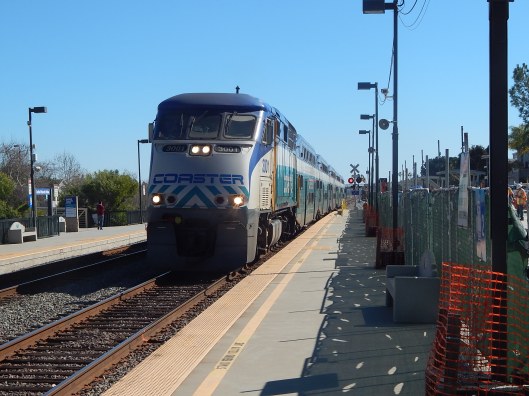
A Coaster Train seen recently at the Poinsettia-Carlsbad Coaster Station. These are the cars bought in the mid 1990’s from Canada. Photo by Noel T. Braymer
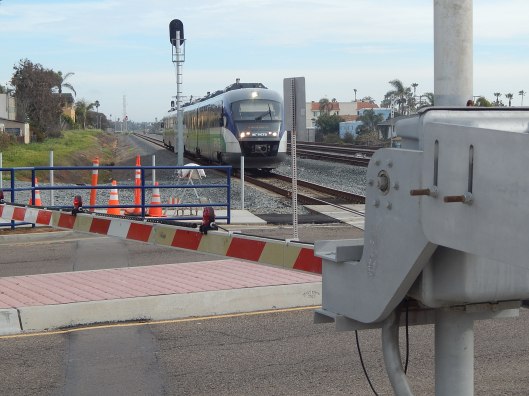
A Sprinter DMU self propelled train arriving at the Oceanside Transit Center. This is at a grade crossing south of the Transit Center. In the picture can be seen some of the grade crossing upgrades to qualify all the grade crossings on the “Surf Line” in Oceanside for Quiet Zones status. Not only will this make the grade crossings safer. But quieter as well since the train horns won’t have to be sounded unless someone or something is in the grade crossing. Photo by Noel T. Braymer
These projects and others have taken years to finally get built. Perhaps the best example of this is preserving Los Angeles Union Station to become the surface transportation hub of not just for Los Angeles, but of Southern California. In the period between 1979-1980 Los Angeles was seriously considering building a “People Mover” for downtown Los Angeles to connect to large parking structures so people’s cars wouldn’t clog the crowded downtown LA streets. The People Mover wouldn’t do anything to reduce freeway traffic since it was only 2 or 3 miles long .The biggest problem was the planning for the People Mover would have built it along south end of the station tracks. This would have blocked future construction of run through tracks at Los Angeles Union Station. Byron and others objected to putting the People Mover where it would prevent future construction of run through tracks. The people planning the People Mover agreed to relocate the route of the People Mover and CRC agreed to support the revised People Mover Project. Then shortly after this around 1981 after the Reagan Administration took office, they cancelled the whole People Mover Project.
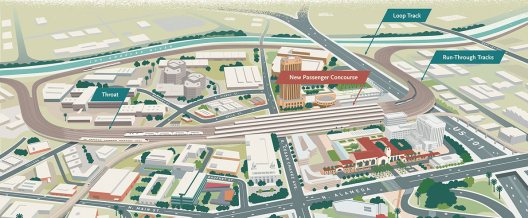
This is a LA Metro drawing of what Los Angeles Union Station could look like with the planned construction of run through tracks over the 101 freeway.
My point is it often takes a lifetime to get projects built and setbacks are common. In 1980 shortly after joining CRC/RailPAC I assumed in about 20 years we would have a network of fast passenger train services connecting most of California, I was still in my late 20’s back then. We have made a lot of progress since 1979. But major construction projects can take years when or if they get built. I remember as a kid growing up in Orange County in the 1960’s of constant stories in the Los Angeles Times and on TV about building “rapid transit” in Los Angeles County. A major part of this was building a “Wilshire Subway” which even then was the busiest travel corridor in Los Angeles. Finally the Southern California Rapid Transit District received a Federal grant so subway construction began in 1985 from Los Angeles Union Station down Wilshire Blvd as far as Western Ave. A leg of the subway split off of Wilshire Blvd north on Vermont to Hollywood and terminated at North Hollywood in the San Fernando Valley. This route wasn’t chosen so much for the most ridership, but to offer service to the most voters. Also in the late 1980’s the Los Angeles County Transportation Commission started work on a Light Rail service between Long Beach and downtown Los Angeles with connections with the now Red Line Subway at 7th and Flower Street.
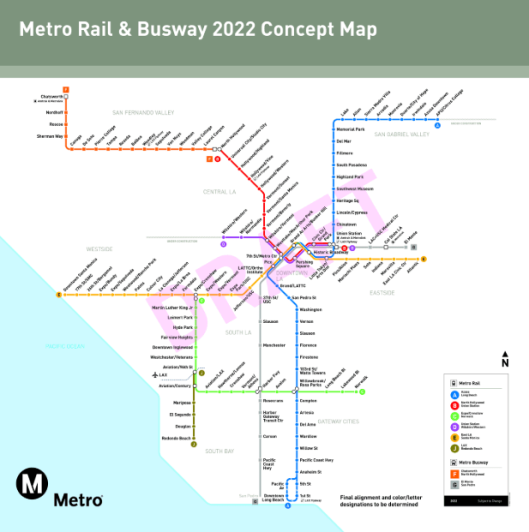
This is a LA Metro map of its rail transit and express bus lines by 2022. Downtown Los Angeles is roughly in the center of this graphic. The Blue Lines runs mostly south of downtown next to the ocean. The Red Line runs roughly west of downtown turning north and west in the San Fernando Valley. At North Hollywood the Red Line ends and the Orange Line Busway begins where there is heavy transfer traffic between these 2 lines.
Even though the Blue Line between Los Angeles and Long Beach started construction well after work began on the subway that then was called the Red Line. The Blue Line went into service in 1990 before the Red Line was finished because it was a cheaper and less complex project built mostly on an old existing railroad that the County bought. When finished the Blue Line was an immediate success. Red Line construction was well over budget, behind schedule and there were serious accidents. Passenger service was opened in 3 stages. First to MacArthur Park by 1993 second to Hollywood and last to North Hollywood by 2000. Ridership on the Red Line when it first open to MacArthur Park was well below projections. What was considered at the time odd was that much of the ridership on the Red Line came from passengers transferring from the Blue Line.
Things got so bad that Los Angeles County decided that no more subways would be built after the Red Line was finished. Many rail projects planned at the end of the 20th century in Los Angeles were postponed because of money shortfalls due to cost overruns building the Red Line. Finally reality forced Los Angeles County to allow tunneling and subway stations for construction of the Gold and Crenshaw/LAX lines as well as the Regional Connector project to extend the Blue and Expo Light Rail lines to serve more of central downtown Los Angeles. Now Los Angeles is extending the Purple Line, which it shares with the Red Line between Union Station to Vermont Ave. The Purple Line now ends at Western Ave. In time for the 2028 Summer Olympic the plan is to extend the Purple Line west to Westwood and serve West Los Angeles. From the 1960’s to the late 2020’s: that’s “only” about 60 years. Many projects can only get built when their time has come, or at least when the opposition to it weakens.
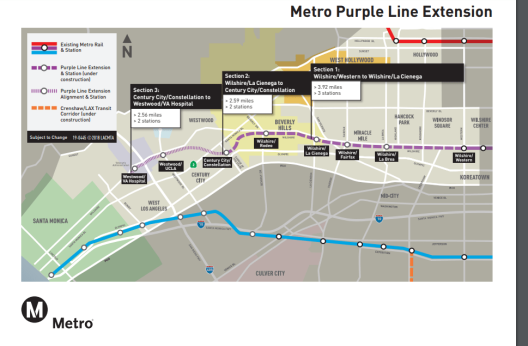
LA Metro Map of the 3 stages extending the Purple Line 9 miles west from Wilshire and Western to Westwood/VA Hospital. At the top right is part of the Red Line in Hollywood. The light blue line under the Purple Line is the Expo Line between Santa Monica and downtown Los Angeles.
The keystone of Byron’s plan in 1970 was the construction of major resort hotels near the Transit Center. This would bring in tourist dollars as well as increase property and sales tax revenues for the City of Oceanside. There have been a couple of resort hotel already built near the Transit Center in recent years as well as new, high density housing in the area of the Transit Center. But the final piece of Byron’s plan for the Transit Center and the area around it is the start of construction this year of 2 resort hotels by the Hyatt company on the last 2 undeveloped land parcels between the beach and the Transit Center. That’s “only” about 35 years after the Transit Center opened and almost 25 years after Byron died. But its likely that the Oceanside Transit Center and Resort District will be around much longer than the Santa Fe Rail Passenger service did in Oceanside which was just under 100 years.
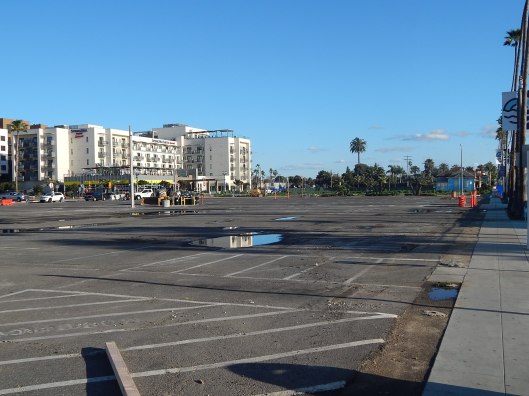
To the top/left is a fairly new resort hotel next to the Oceanside Transit Center.The empty parking lot in the foreground is part of the 2 city blocks for construction of 2 major resort hotels that started construction earlier this year. Photo by Noel T. Braymer

The time required is so depressing, especially when one looks at China and sees what is possible: 29,000 km of high-speed rail, plus multiple subway lines in every major city, all in the past 15 years.
I love traveling around China, in part because I can experience a system that far surpasses anything that will be built in the U.S. in my lifetime, or probably 100 years after that.
LikeLike
I also think about the late Dan Monaghan & what has been accomplished in the Dallas/Ft. Worth area. Rail transit projects have unfortunately outpaced intercity rail expansion. Many NARP board members, like Byron, did not live long enough to see a true national intercity rail passenger system in this country. That is sad.
LikeLike
Byron was never a NARP Board Member. He was part of URPA, the United Rail Passenger Alliance and a friend of Andrew Selden.
LikeLike